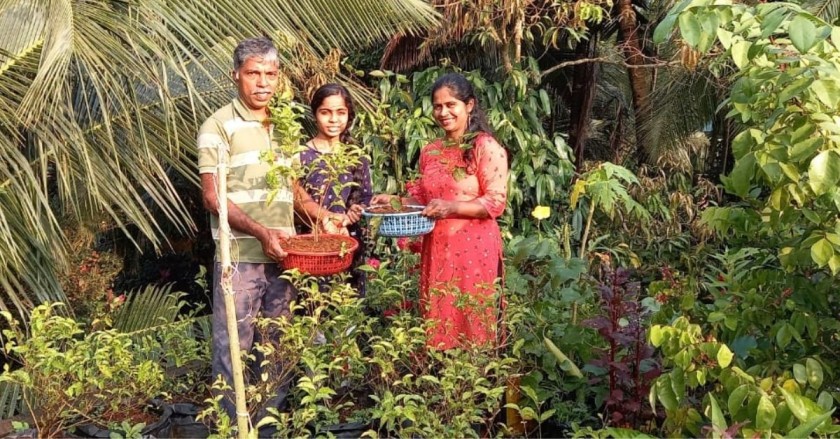Farmer Uses Low-Cost Hydroponics to Grow Jasmine & Chikoo on His Terrace
Low-Cost Hydroponics: Joseph Lobo from Udupi district of Karnataka uses an innovative technique to grow plants on his terrace without any soil.

Shankarapura, a small nondescript village in the Udupi district of Karnataka, is famous for its malliage (refers to jasmine in Kannada). Known for its unique fragrance, this variety of jasmine received a GI tag in 2008 and is also in high demand in India and abroad. Hence the farmers in this village are mostly engaged in growing this special variety of jasmine.
Hailing from the same village, Joseph Lobo was one among the many who grew the Shankarapura jasmine. But what makes this 44-year-old farmer distinctive from others is his interest in experimenting and doing something unique.
“Everybody here in Shankarapura grows this jasmine but I wanted to do something different. What’s the thrill of doing the same thing always? So, I decided to try out hydroponics but in the most economic way. So, I worked out a simple low-cost method and successfully grew them,” Joseph Lobo tells The Better India.
Otherwise an expensive affair, hydroponics is a subset of hydroculture in which plants are grown in water without soil by using mineral nutrient solutions. Here, Lobo has set up a modified hydroponic system to grow plants in his 400 sqft terrace garden. He says that he learnt about the hydroponics method of agriculture while attending a workshop at the University of Agricultural Sciences in Bengaluru and wanted to try a hand at it.
Speaking about the low-cost method he has been implementing, he elaborates, “I use a netted basket and fill it with coco peat, which is organic manure made of coconut husks. Then I take a bucket filled with water mixed with organic manure. The rooted saplings are then carefully planted in the netted basket and this basket will be kept over the bucket in a way that the roots could absorb the nutrients from the liquid manure in it. With all these, it costs me just Rs 170 to set up a plant.”
Lobo shares he also referred to YouTube videos for finding useful tips while setting up his plants.

He claims that hydroponics has an upper hand over conventional methods of agriculture as it eliminates the risk of crops getting affected by soil-borne diseases. He further explains, “Usually it takes around four to five months for a jasmine plant to start flowering. But with this method, the three jasmine plants that I have grown using the hydroponics method, started flowering in just two-and-a-half months.”
Lobo now grows 32 jasmine plants on his terrace garden including three of them using the hydroponics method. Apart from growing the jasmine plants, Lobo used the hydroponic method to grow mulberry and chikoo. “I experimented with the jasmine first and wanted to experiment further. That’s how I tried growing fruit-bearing tree saplings like mulberry and chikoo and it also turned out to be a success,” he says.
“I feel fruit-bearing trees like mulberry and chikoo are better left to be grown on soil than using hydroponics because they grow out to be big trees that require more space. It’s always best to grow plants like jasmine which grow like bushes,” adds Lobo.
Besides being a farmer, Lobo also does landscaping work for a living. Other than growing jasmine plants on his terrace, he also grows over 150 varieties of fruit trees and flowering plants in his 15 cents of land.
“I have varieties of plants and trees from different parts of the world including from countries like Taiwan and several Gulf countries. They are all mostly fruit-bearing trees. I have also set up around 35 beehive boxes on my land,” says Lobo.
Lobo’s family which includes his wife Neema Lobo and college-going daughter Janisha Lobo are all equally supportive of his venture of soil-less cultivation.
Being the first person in his village to experiment with hydroponics, several farmers have approached him to learn the technique he has adapted. “Many people have been reaching out to me before starting jasmine cultivation. I even got an offer of transforming over 20 acres of land into a jasmine field. I couldn’t accept it because I haven’t experimented with hydroponics on a large scale. But I am planning to expand it by planting more jasmine plants using this method,” says Lobo, confidently.
(Edited by Yoshita Rao)
If you found our stories insightful, informative, or even just enjoyable, we invite you to consider making a voluntary payment to support the work we do at The Better India. Your contribution helps us continue producing quality content that educates, inspires, and drives positive change.
Choose one of the payment options below for your contribution-
By paying for the stories you value, you directly contribute to sustaining our efforts focused on making a difference in the world. Together, let’s ensure that impactful stories continue to be told and shared, enriching lives and communities alike.
Thank you for your support. Here are some frequently asked questions you might find helpful to know why you are contributing?


This story made me
-
97
-
121
-
89
-
167













